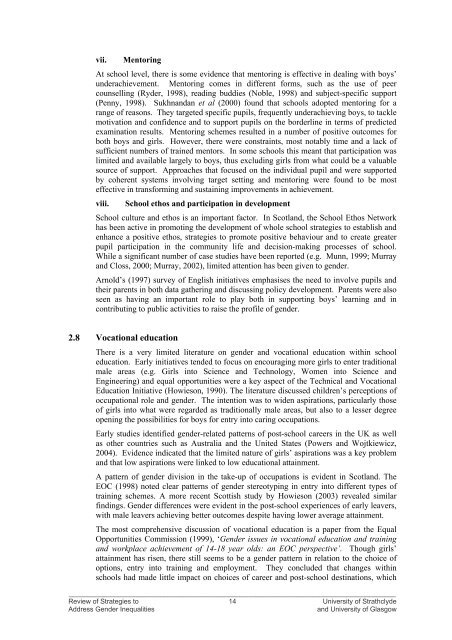Review of Strategies to Address Gender Inequalities in Scottish ...
Review of Strategies to Address Gender Inequalities in Scottish ...
Review of Strategies to Address Gender Inequalities in Scottish ...
Create successful ePaper yourself
Turn your PDF publications into a flip-book with our unique Google optimized e-Paper software.
vii. Men<strong>to</strong>r<strong>in</strong>gAt school level, there is some evidence that men<strong>to</strong>r<strong>in</strong>g is effective <strong>in</strong> deal<strong>in</strong>g with boys’underachievement. Men<strong>to</strong>r<strong>in</strong>g comes <strong>in</strong> different forms, such as the use <strong>of</strong> peercounsell<strong>in</strong>g (Ryder, 1998), read<strong>in</strong>g buddies (Noble, 1998) and subject-specific support(Penny, 1998). Sukhnandan et al (2000) found that schools adopted men<strong>to</strong>r<strong>in</strong>g for arange <strong>of</strong> reasons. They targeted specific pupils, frequently underachiev<strong>in</strong>g boys, <strong>to</strong> tacklemotivation and confidence and <strong>to</strong> support pupils on the borderl<strong>in</strong>e <strong>in</strong> terms <strong>of</strong> predictedexam<strong>in</strong>ation results. Men<strong>to</strong>r<strong>in</strong>g schemes resulted <strong>in</strong> a number <strong>of</strong> positive outcomes forboth boys and girls. However, there were constra<strong>in</strong>ts, most notably time and a lack <strong>of</strong>sufficient numbers <strong>of</strong> tra<strong>in</strong>ed men<strong>to</strong>rs. In some schools this meant that participation waslimited and available largely <strong>to</strong> boys, thus exclud<strong>in</strong>g girls from what could be a valuablesource <strong>of</strong> support. Approaches that focused on the <strong>in</strong>dividual pupil and were supportedby coherent systems <strong>in</strong>volv<strong>in</strong>g target sett<strong>in</strong>g and men<strong>to</strong>r<strong>in</strong>g were found <strong>to</strong> be mosteffective <strong>in</strong> transform<strong>in</strong>g and susta<strong>in</strong><strong>in</strong>g improvements <strong>in</strong> achievement.viii. School ethos and participation <strong>in</strong> developmentSchool culture and ethos is an important fac<strong>to</strong>r. In Scotland, the School Ethos Networkhas been active <strong>in</strong> promot<strong>in</strong>g the development <strong>of</strong> whole school strategies <strong>to</strong> establish andenhance a positive ethos, strategies <strong>to</strong> promote positive behaviour and <strong>to</strong> create greaterpupil participation <strong>in</strong> the community life and decision-mak<strong>in</strong>g processes <strong>of</strong> school.While a significant number <strong>of</strong> case studies have been reported (e.g. Munn, 1999; Murrayand Closs, 2000; Murray, 2002), limited attention has been given <strong>to</strong> gender.Arnold’s (1997) survey <strong>of</strong> English <strong>in</strong>itiatives emphasises the need <strong>to</strong> <strong>in</strong>volve pupils andtheir parents <strong>in</strong> both data gather<strong>in</strong>g and discuss<strong>in</strong>g policy development. Parents were alsoseen as hav<strong>in</strong>g an important role <strong>to</strong> play both <strong>in</strong> support<strong>in</strong>g boys’ learn<strong>in</strong>g and <strong>in</strong>contribut<strong>in</strong>g <strong>to</strong> public activities <strong>to</strong> raise the pr<strong>of</strong>ile <strong>of</strong> gender.2.8 Vocational educationThere is a very limited literature on gender and vocational education with<strong>in</strong> schooleducation. Early <strong>in</strong>itiatives tended <strong>to</strong> focus on encourag<strong>in</strong>g more girls <strong>to</strong> enter traditionalmale areas (e.g. Girls <strong>in</strong><strong>to</strong> Science and Technology, Women <strong>in</strong><strong>to</strong> Science andEng<strong>in</strong>eer<strong>in</strong>g) and equal opportunities were a key aspect <strong>of</strong> the Technical and VocationalEducation Initiative (Howieson, 1990). The literature discussed children’s perceptions <strong>of</strong>occupational role and gender. The <strong>in</strong>tention was <strong>to</strong> widen aspirations, particularly those<strong>of</strong> girls <strong>in</strong><strong>to</strong> what were regarded as traditionally male areas, but also <strong>to</strong> a lesser degreeopen<strong>in</strong>g the possibilities for boys for entry <strong>in</strong><strong>to</strong> car<strong>in</strong>g occupations.Early studies identified gender-related patterns <strong>of</strong> post-school careers <strong>in</strong> the UK as wellas other countries such as Australia and the United States (Powers and Wojtkiewicz,2004). Evidence <strong>in</strong>dicated that the limited nature <strong>of</strong> girls’ aspirations was a key problemand that low aspirations were l<strong>in</strong>ked <strong>to</strong> low educational atta<strong>in</strong>ment.A pattern <strong>of</strong> gender division <strong>in</strong> the take-up <strong>of</strong> occupations is evident <strong>in</strong> Scotland. TheEOC (1998) noted clear patterns <strong>of</strong> gender stereotyp<strong>in</strong>g <strong>in</strong> entry <strong>in</strong><strong>to</strong> different types <strong>of</strong>tra<strong>in</strong><strong>in</strong>g schemes. A more recent <strong>Scottish</strong> study by Howieson (2003) revealed similarf<strong>in</strong>d<strong>in</strong>gs. <strong>Gender</strong> differences were evident <strong>in</strong> the post-school experiences <strong>of</strong> early leavers,with male leavers achiev<strong>in</strong>g better outcomes despite hav<strong>in</strong>g lower average atta<strong>in</strong>ment.The most comprehensive discussion <strong>of</strong> vocational education is a paper from the EqualOpportunities Commission (1999), ‘<strong>Gender</strong> issues <strong>in</strong> vocational education and tra<strong>in</strong><strong>in</strong>gand workplace achievement <strong>of</strong> 14-18 year olds: an EOC perspective’. Though girls’atta<strong>in</strong>ment has risen, there still seems <strong>to</strong> be a gender pattern <strong>in</strong> relation <strong>to</strong> the choice <strong>of</strong>options, entry <strong>in</strong><strong>to</strong> tra<strong>in</strong><strong>in</strong>g and employment. They concluded that changes with<strong>in</strong>schools had made little impact on choices <strong>of</strong> career and post-school dest<strong>in</strong>ations, which______________________________________________________________________________________<strong>Review</strong> <strong>of</strong> <strong>Strategies</strong> <strong>to</strong> 14 University <strong>of</strong> Strathclyde<strong>Address</strong> <strong>Gender</strong> <strong>Inequalities</strong>and University <strong>of</strong> Glasgow
















